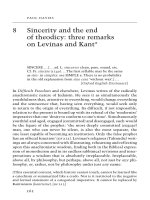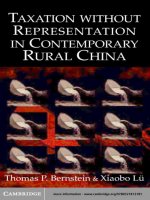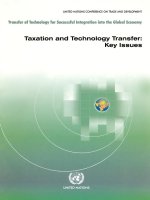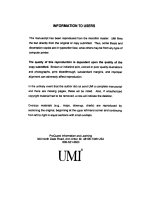THREE ESSAYS ON INNOVATION AND TECHNOLOGY TRANSFER
Bạn đang xem bản rút gọn của tài liệu. Xem và tải ngay bản đầy đủ của tài liệu tại đây (697.95 KB, 212 trang )
THREE ESSAYS ON INNOVATION AND
TECHNOLOGY TRANSFER
ZHANG XUYAO
(B.S. (Hons.), NUS )
A THESIS SUBMITTED
FOR THE DEGREE OF DOCTOR OF PHILOSOPHY
DEPARTMENT OF ECONOMICS
NATIONAL UNIVERSITY OF SINGAPORE
2016
Declaration
I hereby declare that this thesis is my original work and it has been written
by me in its entirety. I have duly acknowledged all the sources of information
which have been used in the thesis.
This thesis has also not been submitted for any degree in any university
previously.
Signed:
Date:
November 16, 2016
i
Acknowledgements
This thesis would have remained a dream without the support and assistance of professors, friends, classmates and my family. I am indebted to all
people that have helped me and made this thesis possible.
First of all, it is with immense gratitude that I acknowledge the guidance
and support of my supervisor, Professor Chiu Yu Ko. His enthusiasm, patience, knowledge and inspiration for research have encouraged me and helped
me when I was writing this thesis. His expertise in industrial organization,
especially in innovation and technology transfer, has improved my research
skills and prepared me for future challenges. I would never imagine having a
better advisor for my PhD study.
I am also grateful for my co-author, Professor Bo Shen, who has spent much
time assisting me, especially in the third chapter of this thesis. I really enjoy
the long discussions with him, from whom I have learnt the way of developing
research ideas and writing professional academic articles. I appreciate his
comments on the revision of the thesis.
I would like to thank my thesis committee members, Professor Jingfeng Lu
and Professor Qiang Fu, my panel members, Professor Satoru Takahashi and
Professor Yi-Chun Chen, for their valuable comments and suggestions. I have
benefited a lot from them, who are patient, encouraging and helpful.
ii
I would also like to thank all my classmates and friends, without whom I
would have never gone through all my boring time when I was struggling with
my research. I really enjoy studying and discussing with all of them.
I would like to express my very great appreciation to all the participants in
joint conferences on ”Logic, Game Theory, and Social Choice 8” and ”The 8th
Pan-Pacific Conference on Game Theory” 2015, the 11th CRESSE Summer
School and Conference in Competition and Regulation 2016, the 2016 Asian
Meeting of the Econometric Society and the NUS Applied Game Theory Reading Group. It is my great honor to have presented my research papers among
them, from whom I have received valuable comments and suggestions.
Last but not the least, I owe my deepest gratitude to my family, especially
my parents, for their selfless love and endless support for me. This thesis is
dedicated to them.
iii
Contents
1 Research Joint Venture with Technology Transfer
1
1.1
Introduction . . . . . . . . . . . . . . . . . . . . . . . . . . . .
1
1.2
A Motivating Example . . . . . . . . . . . . . . . . . . . . . .
6
1.3
Model . . . . . . . . . . . . . . . . . . . . . . . . . . . . . . .
7
1.3.1
Individual Research . . . . . . . . . . . . . . . . . . . .
8
1.3.2
Research Joint Venture . . . . . . . . . . . . . . . . . .
9
1.4
1.5
1.6
Technology Transfer
. . . . . . . . . . . . . . . . . . . . . . .
13
1.4.1
Ex-ante Licensing . . . . . . . . . . . . . . . . . . . . .
14
1.4.2
Ex-post Licensing . . . . . . . . . . . . . . . . . . . . .
16
RJV Formation . . . . . . . . . . . . . . . . . . . . . . . . . .
19
1.5.1
No Licensing
. . . . . . . . . . . . . . . . . . . . . . .
19
1.5.2
Under Licensing . . . . . . . . . . . . . . . . . . . . . .
22
Robustness and Extensions . . . . . . . . . . . . . . . . . . . .
25
1.6.1
25
Multiple RJVs
. . . . . . . . . . . . . . . . . . . . . .
iv
1.7
1.6.2
Imperfect Compatibility . . . . . . . . . . . . . . . . .
26
1.6.3
Spillover . . . . . . . . . . . . . . . . . . . . . . . . . .
27
Conclusion . . . . . . . . . . . . . . . . . . . . . . . . . . . . .
28
2 Reverse Licensing
30
2.1
Introduction . . . . . . . . . . . . . . . . . . . . . . . . . . . .
30
2.2
Model . . . . . . . . . . . . . . . . . . . . . . . . . . . . . . .
37
2.2.1
No licensing . . . . . . . . . . . . . . . . . . . . . . . .
38
2.2.2
Reverse Licensing . . . . . . . . . . . . . . . . . . . . .
39
2.3
Remedy . . . . . . . . . . . . . . . . . . . . . . . . . . . . . .
40
2.4
Alternative Licensing Regimes . . . . . . . . . . . . . . . . . .
46
2.4.1
Independent licensing . . . . . . . . . . . . . . . . . . .
46
2.4.2
Patent Pool . . . . . . . . . . . . . . . . . . . . . . . .
49
2.4.3
Comparison . . . . . . . . . . . . . . . . . . . . . . . .
51
Research and Development . . . . . . . . . . . . . . . . . . . .
56
2.5.1
Before remedy . . . . . . . . . . . . . . . . . . . . . . .
56
2.5.2
After remedy . . . . . . . . . . . . . . . . . . . . . . .
57
Conclusion . . . . . . . . . . . . . . . . . . . . . . . . . . . . .
59
2.5
2.6
3 Corruption, Pollution and Technology Transfer
3.1
Introduction . . . . . . . . . . . . . . . . . . . . . . . . . . . .
v
60
60
3.2
Model . . . . . . . . . . . . . . . . . . . . . . . . . . . . . . .
67
3.3
Without Corruption
. . . . . . . . . . . . . . . . . . . . . . .
70
Equilibria . . . . . . . . . . . . . . . . . . . . . . . . .
70
3.3.1.1
Stage 2: Competition
. . . . . . . . . . . . .
70
3.3.1.2
Stage 1: Firm 2’s choice . . . . . . . . . . . .
72
3.3.2
Consumer Surplus and Pollution . . . . . . . . . . . . .
72
3.3.3
Optimal Taxation Policy . . . . . . . . . . . . . . . . .
74
3.3.1
3.4
3.3.3.1
Case 1: β <
1
,
α2
output-oriented country . . .
75
3.3.3.2
Case 2: β >
1
,
α2
environment-oriented country
76
With Corruption . . . . . . . . . . . . . . . . . . . . . . . . .
77
3.4.1
Equilibria . . . . . . . . . . . . . . . . . . . . . . . . .
78
3.4.1.1
Stage 2: Competition
. . . . . . . . . . . . .
78
3.4.1.2
Stage 1: Firm 2’s Choice . . . . . . . . . . . .
79
3.4.1.3
Summary . . . . . . . . . . . . . . . . . . . .
82
3.4.2
Consumer Surplus and Pollution . . . . . . . . . . . . .
85
3.4.3
Optimal Taxation Policy . . . . . . . . . . . . . . . . .
87
3.4.3.1
β<
1
:
α2
output-oriented country
. . . . . . .
88
3.4.3.2
β>
1
:
α2
environment-oriented country . . . .
90
3.5
Discussion: Outsider Innovator
. . . . . . . . . . . . . . . . .
94
3.6
Conclusion . . . . . . . . . . . . . . . . . . . . . . . . . . . . .
96
vi
Bibliography
98
Appendices
102
A Proofs and Details of Chapter One
102
A.1 Proofs . . . . . . . . . . . . . . . . . . . . . . . . . . . . . . .
102
A.2 Detailed Calculations and Extentions . . . . . . . . . . . . . .
118
B Proofs and Details of Chapter Two
139
B.1 Proofs . . . . . . . . . . . . . . . . . . . . . . . . . . . . . . .
139
B.2 Fixed Fee Compensation Scheme . . . . . . . . . . . . . . . .
150
C Proofs and Details of Chapter Three
164
C.1 Proofs . . . . . . . . . . . . . . . . . . . . . . . . . . . . . . .
164
C.2 Detailed Discussions . . . . . . . . . . . . . . . . . . . . . . .
176
vii
Summary
This thesis consists of three independent chapters on innovation and technology transfer.1
The first chapter studies a model of research joint venture (RJV) competition where all firms, including firms in the RJV, independently choose their
investments for process innovation before they compete in a Cournot market.
Even with perfect spillovers between RJV firms, an industry-wide RJV does
not lead to a better technological development and a higher consumer surplus,
compared to the case without any RJV. Yet, every non-industry-wide RJV
lead to strict improvements for both measures. Moreover, the improvements
are larger when firms may license their technologies after making R&D investments. Government should encourage innovation through collaboration with
technology transfer as an alternative to concerting an industry-wide cooperative effort.
The second chapter studies reverse licensing imposed by an upstream monopolist that requires downstream producers to surrender their patents so that
the upstream monopolist may incorporate all the technologies into the interThe first and second chapter is co-authored with my supervisor Professor Chiu Yu Ko,
while the third chapter is co-authored with my supervisor, Professor Chiu Yu Ko, and Bo
Shen.
1
viii
mediate goods. Qualcomm, the world largest smartphone chip producer and
the monopolist in the Chinese market, was ruled by Chinese government that
its reverse licensing was anticompetitive, and that it must compensate downstream producers for patents surrendered. The chapter shows that reverse
licensing yields the highest consumer surplus, aggregate profit, and hence social welfare, compared to the cases without licensing, with independent royalty
licensing, and patent pool. Moreover, the remedy that requires compensation
for surrendered patents will lead to a greater incentive to innovate, especially
to firms with better technologies.
The third chapter studies the optimal environmental tax under the possibility of corruption and licensing of a clean technology. In an environmentoriented country, the firm with dirty technology may choose to bribe the bureaucrat to mislead the actual emission, rather than adopt the clean technology. Government should set a very high environmental tax, and corruption
may improve social welfare in comparing with licensing. Higher wage for bureaucrat could effectively reduce corruption, but also hinder the incentive for
the clean firm to license the technology. Technology transfer is more likely to
occur in an output-oriented country. Government should set a low tax rate to
induce high incentive for the license and adoption.
ix
List of Figures
2.1
Consumer surplus varies with compatibility . . . . . . . . . . .
55
3.1
Equilibrium Region for Licensing and No . . . . . . . . . . . .
81
3.2
Equilibrium Region when
√
2−1<σ <
x
1
2
. . . . . . . . . . .
85
List of Tables
1.1
Equilibrium RJV Size under various research efficiencies and
industry size. . . . . . . . . . . . . . . . . . . . . . . . . . . .
1.2
21
Equilibrium RJV Size and Licensee under different research efficiencies.
. . . . . . . . . . . . . . . . . . . . . . . . . . . . .
xi
22
Chapter 1
Research Joint Venture with
Technology Transfer
1.1
Introduction
Research joint ventures (RJVs) are analyzed under the rule of reason in US
since 1984. National Cooperative Research Act of 1984 (PL-98-42) states that
“...the conduct of any person in making or performing a contract to carry out a
joint research and development venture shall not be deemed illegal per se ...”. 1
Antitrust authorities should be lenient towards the formation of a research
joint venture (RJV) if it does not reduce competition. Since then, RJVs have
becoming increasingly popular around the world. 2
When RJV firms cooperate in research development, they are more willBefore 1984, antitrust authorities have prevented firms from forming RJVs (Grossman
and Shapiro 1986). In 1993, a new amendment (PL-98-462) was passed to further reduce
potential antitrust liability for a research joint venture. In 2004, the latest amendment
(PL-108-237) included standard development organization into the Act.
2
Hernan et al. (2003) document that there are 1229 and 892 RJVs formed in EU from
1986 to 1996 in information technology and aerospace industries respectively.
1
1
ing to spend resources on research due to positive spillovers. As RJV firms
have lower costs of productions, there will be more intense competition in the
product market and thereby leading to a lower price and a higher level of
consumer surplus. However, in a seminal paper by Kamien et al. (1992), a
RJV may fail to achieve any one of these objectives, and may even be worsen
than no RJV at all. They consider a RJV competition where every firm simultaneously chooses research level followed by non-cooperative competition in
the product market. 3 They show that the formation of an industry-wide RJV
reduces effective investment level and consumer surplus comparing with firms
doing individual research. First, this industry-wide RJV is not plausible in
reality. Second, this anti-competitive nature of RJV is at odds with development of antitrust law in US. Their key assumption is that all firms either form
a single RJV or no RJV. However, when all firms are in the RJV, they have
very little incentive to do research given spillover to the other firms, and thus
this rules out the important channel to promote competition in the research
phase (Proposition 1.1).
We relax this assumption to allow an RJV formed by only some firms in
the industry. We show that any RJV that is not industry-wide leads to strictly
An RJV competition resembles the case that firms are assigned different tasks, and the
whole project is the combination of the tasks. One example is software industry. They also
consider RJV cartel where firms cooperate in their R&D activities to maximize the joint
profit. Pharmaceutical industries seems to fall in this category.
3
2
lower total production costs and a higher level of consumer surplus (Theorem
1.1). This is consistent with the motivation that taking RJVs under the rule
of reason in US.
With RJV firms possessing a more advanced technology than non-RJV
firms, technology transfers through licensing is an important channel to recoup
costs from research. As RJV firms do not share the full burden of research
cost, they should have stronger incentive to innovate. However, licensing may
reduce firms’ incentive to innovate due to substitution between innovation
and licensing.4 We find that the timing for licensing is crucial for the welfare
analysis due to strategic behavior of licensees. 5 On the one hand, if licensing
agreement is signed before the research stage (ex-ante licensing), the licensees
have no incentive to do any investment. On the other hand, if firms reach
licensing agreement after research stage (ex-post licensing), licensees have incentive to do research to improve the bargaining position with the RJV firms.
We show that ex-post licensing leads to more advanced technological development and improved consumer surplus, in comparison with no licensing. For
ex-ante licensing, although technological investment is reduced compared with
no licensing, consumer surplus could be improved compared to no licensing if
Chang et al. (2013) show that when only one firm can do innovation, an (ex-post)
licensing may reduce incentive to innovate and welfare.
5
Gallini and Winter (1985) consider a dynamic duopoly model with different initial cost
for firms, and stochastic process for the R&D. They show that when initial cost are close,
ex-post licensing encourages R&D; while ex-ante agreement is unlikely to be formed.
4
3
(i) R&D cost is high, (ii) RJV size is small relative to the industry size, and
(iii) number of licensee is few (Theorem 1.2).
To determine the equilibrium RJV size, we consider a simple RJV formation game. Without licensing, an industry-wide RJV does not maximize
profits of its members, implying that if an industry features only one single
RJV with closed membership, the RJV will not include all of the firms in the
industry (Proposition 1.5). This suggests that policy implication based on
the analysis on industry-wide RJV may require further scrutiny. For welfare
analysis, our equilibrium RJV size is less than the social optimal one because
RJV firms restrict innovation to lessen product market competition. Under
ex-ante licensing, the equilibrium RJV is smaller because there will be technology transfer to non-RJV firms. For ex-post licensing, the equilibrium RJV
size shrinks further. In particular, when research is not too efficient, the equilibrium size of RJV is always two regardless of number of firms in the industry.
This implies that when institutional environment is conducive to licensing (for
example, adequate protection of property right), then it may be difficult for the
government to encourage an industry-wide agreement to consolidate research.
In the RJV literature, most focuses on RJV cartel and few studies RJV
competition.6 Katz (1986) shows that a RJV competition delivers better conOur paper parallels Poyago-Theotoky (1995) that studies equilibrium and optimal size
of RJV using numerical method under a setting of RJV cartel.
6
4
sumer surplus than the absence of a RJV, when RJV firms share their research
costs according to some explicit rule. d’Aspermont and Jacquemin (1998) compare welfare consequence under RJV competition and RJV cartel in a duopoly,
which is extended to a more general framework by Suzumura (1992). 7 Kaimen
et al. (1992) show that in an oligopoly model, RJV cartel is consumer-surplus
dominate no RJV which in turn dominates RJV competition. Greenlee (2005)
studies RJV competition under some coalition formation games, and show
that an industry-wide RJV improves welfare when spillover is low. To our
knowledge, this is the first paper to formally study RJV competition for nonindustry-wide RJV without cost sharing.
Our paper also contributes to the recent development in licensing literature
to endogenzie the innovation process. Gallini and Winter (1986) study how
ex-ante or ex-post licensing in a R&D game in a duopoly market. Recently, Sen
and Tauman (2007) study how ex-post licensing affects incentive to innovate
in an oligopolistic industry where only one innovator can do R&D. Ding and
Ko (2016) study how ex-post licensing changes patent competition when all
firms may invest in R&D.
The rest of the paper is organized as follows. Next section presents a
motivating example. Section 1.3 presents a model of RJV competition. Section
In RJV cartel, firms cooperate in their R&D activities to maximize the joint profit but
still choose their product non-cooperatively.
7
5
1.4 extends the model with technology transfer, and Section 1.5 discusses the
equilibrium size of RJV. Section 1.6 considers robustness and extensions, and
Section 1.7 concludes. For exposition, some of precise statements of formal
results and most of the proofs are relegated to Appendix.
1.2
A Motivating Example
Consider four firms competing in a Cournot market with positive marginal
cost of production and zero fixed cost. Firms can invest in R&D to reduce this
marginal cost. Consider a complete-information two-stage game where firms
simultaneously decide their investments followed by production.
First consider a RJV formed by firms 1 and 2. Assume perfect spillover
within the RJV that the reduction of marginal cost of any RJV firm is the
aggregation of technological development of both firms 1 and 2. Compare the
equilibrium with the case of four firms doing research individually, we have a
two-firm RJV is superior to individual research in terms of both technological
improvements and consumer surplus. 8 We will later show that this result holds
in general in our Theorem 1.1.
As RJV firms spend more on R&D, they may license their advanced technology to non-RJV firms to increase their profits. Following Gallini and Winter
The same result holds for the case where 3 firms form the RJV. However, in a simple
RJV formation game in Section 3.3, the equilibrium RJV consists of two firms. Details of
calculation can be found in Appendix A.2.1.
8
6
(1985), the licensing can be before research stage (ex-ante licensing) or after
research stage (ex-post licensing). Consider a licensing auction by Katz and
Shapiro (1986) where the licensor announces the number of license for sale. In
equilibrium, RJV firms will license to two non-RJV firms in both ex-ante and
ex-post licensing cases, if the research cost is sufficiently high. We can show
an ex-post licensing further improves technology development and consumer
surplus. RJV firms (firms 1 and 2) have more incentive to do R&D, because
research cost can be recovered from the licensing fees. However, an ex-ante
licensing reduces the technological development and consumer surplus, due to
the free riding effect from the licensees. As our Theorem 1.2 shows, the result
about ex-post licensing continues to hold in general setup but ex-ante licensing
could still improves consumer surplus under some plausible conditions.
1.3
Model
We first study the benchmark case where all firms choose their research investment individually. Then we study the case when a single RJV formed by
all firms in order to compare our result with Kaimen et al. (1992). Finally,
we consider the cases when some firms are not in the RJV.
For tractability, there are two important departures from Kamien et al.
(1992). First, we follow other papers (for example, d’Aspremont and Jacquemin
7
1988; Poyago-Theotoky 1995) in the literature to consider a standard linear
demand function and a quadratic research cost function instead of a general
demand function and a concave cost reduction function. Second, patent protection is perfect such that firms belonging to the RJV (referred as RJV
firms) have a perfect information sharing, while firms outside RJV (referred
as non-RJV firms) could not enjoy any spillover. 9 As discussed in Section
1.6, our main results remain valid when we remove the second departure.
1.3.1
Individual Research
There are N ≥ 3 firms in a homogeneous good market with no fixed cost of
production. Firms are indexed as i ∈ {1, ∙ ∙ ∙ , N } and firm i has the marginal
cost ci . With a small abuse of notation, let the set {1, . . . , N } be denoted
by N as well. Initially, all firms have the same production cost ci = c for all
i ∈ N . The inverse demand function is p = a − Q where Q =
i∈N
qi is the
aggregate production and qi is the production by firm i.
We consider the following two-stage game. In the first stage, each firm
i ∈ N simultaneously chooses to level of marginal cost reduction xi so that
the new marginal cost is ci = c − xi . To reduce marginal cost by xi , firm
i has to incur a research cost αx2i where α captures research efficiency and
Majewski (2008) documents that RJVs registered with US antitrust authority and found
that RJVs exert huge effort to avoid unintended spillover to third parties.
9
8
the quadratic expression reflects the decreasing return in investment. 10 In the
second stage, firms simultaneously choose their production. The profit for firm
i is πiind = (p − ci )qi − αx2i . Throughout this paper, we assume α is sufficiently
large such that production costs are non-negative after research. Following the
standard assumption in the literature, all N firms remain active in the Cournot
competition. Using backward induction, the equilibrium production by firm i
is qi =
a−N ci + j=i cj
.
N +1
The following lemma characterizes the subgame-perfect
equilibrium.11
Lemma 1.1. Under individual research, every firm i ∈ N invests xind
=
i
N
(a − c),
α(N +1)2 −N
α(α(N +1)2 −N 2 )
(a
(α(N +1)2 −N )2
1.3.2
produces qiind =
α(N +1)
(a − c)
α(N +1)2 −N
and earns a profit of πiind =
− c)2 .
Research Joint Venture
Consider a research joint venture (RJV) formed by K ⊆ N firms. RJV firms
share their research progress so that the cost reduction for firm k ∈ K is
XK ≡
i∈K
xi . We first consider an industry-wide RJV (K = N ) to compare
our model with Kaimen et al. (1992). By backward induction, we have, for
We require α to be not too small to guarantee non-negativity of production cost and
second-order conditions as d’Aspremont and Jacquemin (1988) and Poyao-Theotoky (1995).
The conditions can be found in the proof.
11
From Lemma 1, it is evident that marginal costs are non-negative if and only if α >
∗
αind ≡ c(NaN
+1)2 .
10
9
all i ∈ N ,
xall
i =
a−c
α(N + 1)(a − c)
xind
i
=
, and qiall =
= qiind .
2
2
α(N + 1) − N
N
α(N + 1) − N
With the formation of the RJV, each firm is investing less than the case with2
ind 2
out the RJV because α(xall
i ) < α(xi ) , but they can achieve the same level
of cost reduction as XN =
i∈N
ind
xall
i = xi . Therefore, the formation of the
RJV reduces overlapping research efforts due to spillover within RJV firms.
Moreover, consumer surplus, measured by (
i∈N
qi )2 , is the same for both
individual research and industry-wide RJV cases. This results is consistent
with Kamien et al. (1992) that they show an industry-wide RJV leads to no
better technological improvement (
((
i∈N
qiall )2 ≤ (
i∈N
i∈N
xall
≤ xind
i
i ) and consumer surplus
qiind )2 ), where equalities hold if and only if spillover
within RJV is perfect. Our first proposition summarizes the above observation.12
Proposition 1.1. An industry-wide RJV leads to the same technological improvement and consumer surplus compared to the case of individual research.
Now we consider a K-firm RJV (K
N ), and will show that a K-firm
RJV could achieve the higher level of technological development and consumer
Throughout this paper, we will use the term technological improvements (or developments) as a short-hand notation for industrial level technological improvements.
12
10
surplus. The profit functions for RJV and non-RJV firms are
πino = (p − (c −
πjno
k∈K
xk ))qi − αx2i for all i ∈ K, and
= (p − (c − xj ))qj − αx2j for all j ∈ N \K.13
By backward induction, technological improvements and quantity produced
by RJV firms and non-RJV firms (assuming solution is interior) are
(N − K + 1)[α(N + 1)2 − N (N + 1)]
(a − c) for all i ∈ K,
Dno
N (α(N + 1)2 − K(N − K + 1)(N + 1))
=
(a − c) for all j ∈ N \K,
Dno
α(N + 1)2 (α(N + 1) − N )
=
(a − c) for all i ∈ K,
Dno
α(N + 1)2 (α(N + 1) − k(N − K + 1))
=
(a − c) for all j ∈ N \K, and
Dno
xno
i =
xno
j
qino
qjno
where Dno = (α(N + 1)2 − N (K + 1))(α(N + 1)2 − K(N − K + 1)2 ) − (N −
K)(N −K +1)N K 2 . We assume α is large enough to guarantee non-negativity
of production cost and production. 14 It is easy to check qino > qjno for all i ∈ K
and j ∈ N \K. RJV firms will produce more than the non-RJV firms, due to
the fact that they have advanced technology level, i.e.
i∈K
no
xno
i > xj for all
j ∈ N \K.
Comparing equilibrium outcomes under a K-firm RJV, an industry-wide
RJV and independent research, we can show that any K-firm RJV achieves
The superscript “no” refers to no licensing to be distinguished from ex-post licensing
“Ex-post” and ex-ante licensing “Ex-ante” in next section.
14
∗
∗
The sufficient conditions are α > αno
(a, c) and α ≥ K(NN−K+1)
respectively where αno
+1
no
is the larger root for the quadratic function Kxi = c for i ∈ K.
13
11
higher level of cost reduction and consumer surplus.
Theorem 1.1. Every RJV formed by K
N firms yields a higher technolog-
ical development and consumer surplus than the cases of individual research
and an industry-wide RJV.
Even though an industry-wide RJV does not improve the technological development and consumer surplus, a K-firm RJV leads to strict improvements
on them. Comparing the cases of K-firm RJV and of independent research,
RJV firms have additional incentive to spend more on research in aggregate
level due to the advantageous position by information sharing nature of RJV.
15
However, as number of firms in a K-firm RJV increases, the advantageous
position eventually diminished because more RJV-firms share advanced technology but non-RJV firms becomes fewer. Hence, after the number of firms
belonging to the RJV exceeds some threshold, they will start decreasing investment, in order to reduce the production level competition. Eventually,
when K = N , firms just want to maintain the aggregate level of technology
as if they are doing individual research. 16
Even though individual firm is spending less in R&D, xno
< xind
i
i , due to free-riding
no
ind
nature of RJV. The aggregate R&D level is higher, i∈K xi > xi , due to the information
sharing nature of RJV.
16
Whenever α is not too small, the profit of an RJV firm is single peak in the size of the
RJV. The threshold value of α is around one-seventh of N . When α is very small, then the
profit of an RJV firm has two peaks in the size of the RJV.
15
12
1.4
Technology Transfer
Since RJV firms tend to possesse superior technology to non-RJV firms, they
may find it beneficial to transfer technology if the licensing fees exceed the negative spillover from technology diffusion. Under RJV competition, since RJV
firms choose their investments independently, the licensing decision should
be approved unanimously. 17 However, this does not pose a problem in our
framework because all RJV firms are symmetric in the unique equilibrium.
Following Gallini and Winter (1985), we consider licensing before (ex-ante
licensing) and after (ex-post licensing) the research being done. An example of ex-ante licensing is package licensing where licensees are entitled
to enjoy all the subsequent technology development. Ex-post licensing is a
very common method to transfer technology in many industries such as smart
phone industry. Formally, we define a dynamic game of three stages, namely
licensing stage, research stage and production stage. In an ex-ante licensing
scenario, the game proceeds from licensing stage to research stage and finally
to production; while in ex-post licensing scenario, the game proceeds from
research stage to licensing stage and finally to production stage. For the licensing mechanism, we follow Katz and Shapiro (1986) to consider licensing
However, under RJV cartel, this is implicitly assumed as licensing decision is made to
maximize joint profits of RJV firms under the same assumption imposed on investment
levels. Majewski (2008) documents that technology transfers by RJVs require approvals
from all members.
17
13









